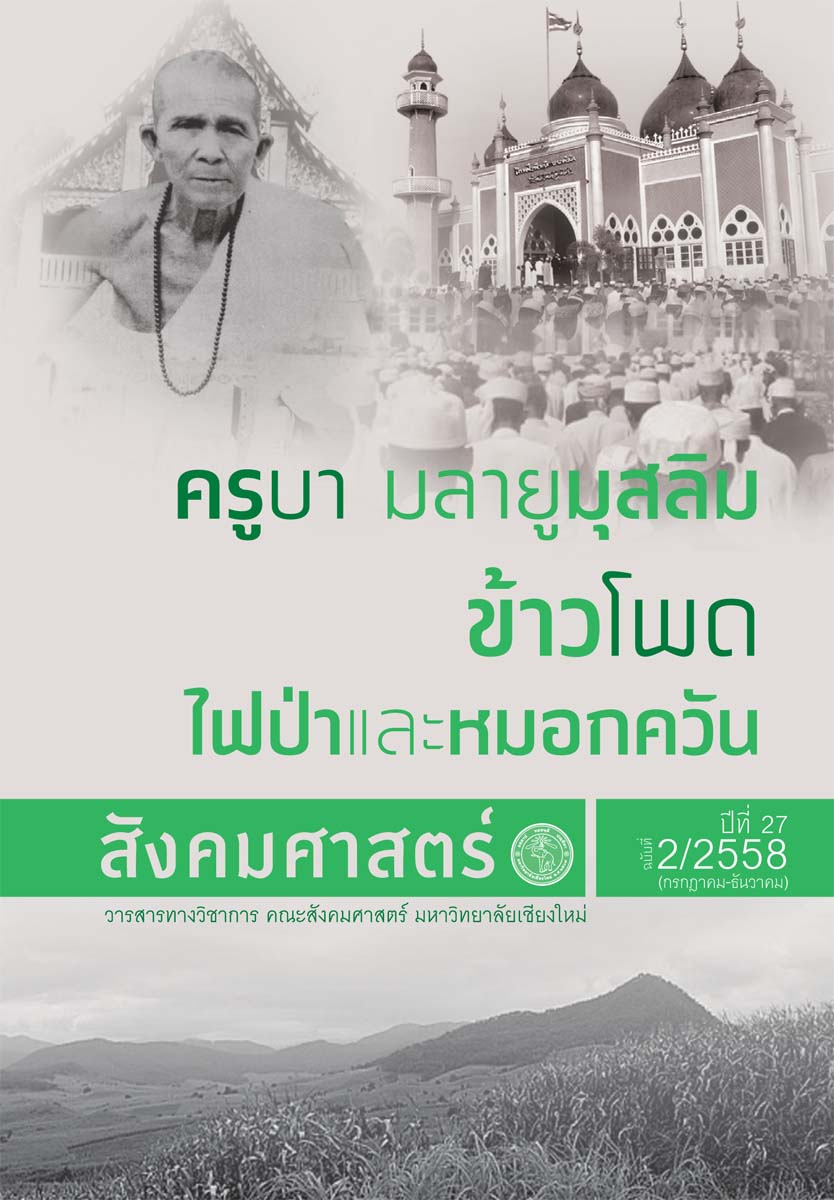Forest Fire and Haze Management: Lessons Learned from the Multi-stakeholder Collaborative Management in Chiang Mai Province
Main Article Content
Abstract
Forest fires and haze problems could be decreased owing to collaborative management among local relevant stakeholders. This paper depicts the lessons learned of forest fire management in dry dipterocarp forests having forest fires every year. The significant stakeholders compose of villagers, officers of forest fire control stations, Chom Thong District, local governments and researchers. They had co-operated forest fire reduction experiments during 2012-2015 in Chom Thong District. After evaluating the causes of forest fire and the obstructions of forest fire control in the past, the stakeholders had changed their former forest fire control methods to prescribed burning to reduce fuel in dry dipterocarp forests. This method has been widely accepted as it is suitable for topography, forest types, climate, and villager socio-economic circumstances. The prescribed burning was capable to reduce forest fires and haze comparing with the past. The stakeholders also co-experimented and created their own systematic forest fire management to the local circumstances. The success factor comes from villagers’ ability to choose appropriate forest fire management able to reduce time, labors and cost of forest fire control. Additionally, the prescribed burning in this area had less effect to climate quality while the fire intensity during the burning was still low and acceptable to have less damage to saplings and sprouts. During the four years of co-experiments, prescribed burning has been more accepted and widely applied in dry dipterocarp forests of Chiang Mai Province.
Article Details
All written articles published on Journal of Social Sciences is its author’s opinion which is not belonged to Faculty of Social Sciences, Chiang Mai University or is not in a responsibility of the journal’s editorial committee’s members.
References
ฉลาดชาย รมิตานนท์. 2527. “สภาพทางเศรษฐกิจ การเมือง สังคม และวัฒนธรรมของสังคมหมู่บ้านชนบทกับการมีส่วนร่วมของประชาชน: วิเคราะห์กรณีหมู่บ้านภาคเหนือ”.ใน ทวีทอง หงษ์วิวัฒน์ (บรรณาธิการ), การมีส่วนร่วมของประชาชนในการพัฒนา,หน้า 115-163. กรุงเทพฯ: ศูนย์ศึกษานโยบายสาธารณสุข มหาวิทยาลัยมหิดล.
ชฎา ณรงค์ฤทธิ์ และชนินทร์ อัมพรสถิร. 2552. การพัฒนาระบบเตือนภัยไฟป่าและมลพิษทางอากาศจากไฟป่าในจังหวัดแม่ฮ่องสอนบนระบบภูมิสารสนเทศเครือข่ายสาธารณะ. พิษณุโลก: คณะเกษตรศาสตร์ ทรัพยากรธรรมชาติ และสิ่งแวดล้อมมหาวิทยาลัยนเรศวร.
ศุทธินี ดนตรี ชาคริต โชติอมรศักดิ์ นุชิต จันทาพูน พัชรี เพ็ชรเจริญ ปรัชญา ปิ่น ขันธะยงค์และศุภลักษณ์ หน้อยสุยะ. 2557ก. การลดปริมาณเชื้อเพลิงด้วยการจัดการเชิงปฏิบัติการอย่างมีส่วนร่วมเพื่อลดจำนวนไฟป่า: กรณีศึกษาตำบลสบเตี๊ยะอำเภอจอมทอง จังหวัดเชียงใหม่. เชียงใหม่: ภาควิชาภูมิศาสตร์ คณะสังคมศาสตร์มหาวิทยาลัยเชียงใหม่.
ศุทธินี ดนตรี สัญญา ทุมตะขบ พิภพ ชำนิวิกัยพงศ์ และศุภลักษณ์ หน้อยสุยะ. 2554.การจัดลำดับความสำคัญของพื้นที่เผาจากข้อมูลเชิงพื้นที่หลายแหล่ง เพื่อการเฝ้าระวัง
และการป้องกันการเผาในที่โล่งในจังหวัดเชียงใหม่. เชียงใหม่: ภาควิชาภูมิศาสตร์คณะสังคมศาสตร์ มหาวิทยาลัยเชียงใหม่.
ศุทธินี ดนตรี อภิรดี สรวิสูตร พจนา พิชิตปัจจา ปรัชญา ปิ่นขันธะยงค์ และศุภลักษณ์หน้อยสุยะ. 2557ข. การจำแนกเชิงพื้นที่ของพื้นที่เผาไหม้ เพื่อการเฝ้าระวังและการป้องกันการเผาในที่โล่ง: กรณีศึกษาจังหวัดเชียงใหม่ ลำพูน และแม่ฮ่องสอน.เชียงใหม่: ภาควิชาภูมิศาสตร์ คณะสังคมศาสตร์ มหาวิทยาลัยเชียงใหม่.
สมศักดิ์ สุขวงศ์. 2550. การจัดการป่าชุมชนเพื่อคนและเพื่อป่า. กรุงเทพฯ: บริษัททวีวัฒน์การพิมพ์.
สรณรัชฎ์ กาญจนะวณิชย์. 2537. “ไฟป่า เจ้าแม่กาลีแห่งพงไพร,” สารคดี ปีที่ 9 ฉบับที่ 108,หน้า 110-128.
สันต์ เกตุปราณีต. 2530. นิเวศวิทยาไฟป่า. กรุงเทพฯ: ภาควิชาวนวัฒนวิทยา คณะวนศาสตร์มหาวิทยาลัยเกษตรศาสตร์.
สำนักงานพัฒนาเทคโนโลยีอวกาศและภูมิสารสนเทศ (องค์การมหาชน) กระทรวงวิทยาศาสตร์และเทคโนโลยี. 2550. รายงานสรุปการประยุกต์ใช้ข้อมูลดาวเทียม Landsat 5เพื่อหาพื้นที่เกิดไฟป่าปี พ.ศ.2550. กรุงเทพฯ: สำนักงานพัฒนาเทคโนโลยีอวกาศและภูมิสารสนเทศ (องค์การมหาชน).
อริศรา เจริญปัญญาเนตร. 2552. ระบบข้อมูลแบบใกล้เวลาจริงสำหรับการวิเคราะห์พื้นที่เสี่ยงต่อการเกิดไฟป่า ในพื้นที่อุทยานแห่งชาติดอยภูคา จังหวัดน่าน. เชียงใหม่:โครงการจัดการพื้นที่คุ้มครองอย่างมีส่วนร่วม อุทยานแห่งชาติดอยภูคา สถาบันทรัพยากรและสิ่งแวดล้อมแม่โขง.
อรุณี เวียงแสง ตุลวัตร พานิชเจริญ วราลักษณ์ ไชยทัพ และนัยนา หวายคำ. 2548.การติดตามและประเมินผลแบบมีส่วนร่วม. กรุงเทพฯ: โครงการเสริมสร้างการเรียนรู้เพื่อชุมชนเป็นสุข (สรส.).
ภาษาอังกฤษ
Epting, J.; Verbyla, D. and Sorbel B. 2005. “Evaluation of Remotely Sensed Indicesfor Assessing Burn Severity in Interior Alaska Using Landsat TM and ETM+”,Remote Sensing of Environment 96(2005): 328-339.
Fisher, R. J., Durst, P. B., Enters, T. and Victor, M. 2000. “Overview of Themes and Issues in Devolution and Decentralization of Forest Management in Asia and the Pacific”. In T. Enters, P. B. Durst and M. Victor (eds.), Decentralizationand Devolution of Forest Management in Asia and the Pacific. Bangkok:Regional Community Forestry Training Center; FAO Regional Office for Asia and the Pacific.
Ganz, D., Moore, P. and Shields, B. 2000. International Workshop on Community Based Fire Management. Bangkok: RECOFTC.
Hewitt, K. 1997. Regions of Risk, A Geographical Introduction to Disasters. Harlow: Longman.
Karki, Sameer. 2002. Community Involvement in and Management of Forest Fires in South East Asia. Jakarta: Project FireFight South East Asia.
Saglam, B., Bilgili E., Durmaz, B. D., Kadiogullari, A. I. and Kucuk, O. 2008.“Spatio-temporal Analysis of Forest Fire Risk and Danger Using LandsatImagery”, Sensors 8: 3970-3987.
Smith, K. 2001. Environmental Hazard Assessing Risk and Reducing Disaster.London and New York: Routledge.
Tobin, G. A. and Montz, B. E. 2004. “Natural Hazards and Technology: Vulnerability, Risk and Community Response in Hazardous Environments”. In S. D. Brunn, S. L. Cutter and J. W. Harrington (eds.), Geography and Technology, pp. 547-570. Dordretch: Kluwer Academic Publishers


